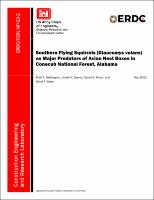Please use this identifier to cite or link to this item:
https://hdl.handle.net/11681/44320| Title: | Southern Flying Squirrels (Glaucomys volans) as major predators of avian nest boxes |
| Authors: | DeGregorio, Brett A. Sperry, Jinelle H. Kovar, Daniel G. Steen, David A. |
| Keywords: | Bird populations Birds--Nests--Effect of predation on Southern flying squirrel Longleaf pine |
| Publisher: | Engineer Research and Development Center (U.S.) |
| Series/Report no.: | Miscellaneous Paper (Engineer Research and Development Center (U.S.)) ; no. ERDC/CERL MP-22-2 |
| Is Version Of: | DeGregorio, Brett A., Jinelle H. Sperry, Daniel G. Kovar, and David A. Steen. "Southern Flying Squirrels (Glaucomys volans) as Major Predators of Avian Nest Boxes in Conecuh National Forest, Alabama." Southeastern Naturalist 18, no. 3 (2019): 476-488. https://doi.org/10.1656/058.018.0313 |
| Abstract: | Bird population dynamics are strongly affected by the ability to successfully reproduce, and nest predation is the primary cause of reproductive failure for most birds. Efforts to understand nest predation and manage its effects on species of conservation concern require knowledge of the ecology of associated predator assemblages. Recently, studies using cameras to record events at nests have illuminated this previously under-studied avian life stage, but such studies have been largely limited to open-cup nests. Cavity nests may be depredated by a different suite of predators and incubating or brooding females occupying such nests may be more vulnerable to predation relative to open-cup nests. Here, we used motion-activated, infrared trail cameras to record predators of artificial nest boxes in a Pinus palustris Mill. (Longleaf Pine) forest in southern Alabama. Although Glaucomys Volans L. (Southern Flying Squirrel) have only rarely been captured on film preying on nests, we found them to be responsible for the vast majority (84%) of bird-nest depredations at nest boxes, and these depredations contributed to a surprisingly low overall rate of nest success (~20%). These results may have implications for the conservation of birds that nest in artificial cavities in Longleaf Pine forests and highlight the importance of further studies on predator assemblages and their effects on nesting birds. |
| Description: | Miscellaneous Paper |
| Gov't Doc #: | ERDC/CERL MP-22-2 |
| Rights: | Approved for Public Release; Distribution is Unlimited |
| URI: | https://hdl.handle.net/11681/44320 http://dx.doi.org/10.21079/11681/44320 |
| Appears in Collections: | Miscellaneous Paper |
Files in This Item:
| File | Description | Size | Format | |
|---|---|---|---|---|
| ERDC-CERL MP-22-2.pdf | 1.38 MB | Adobe PDF |  View/Open |